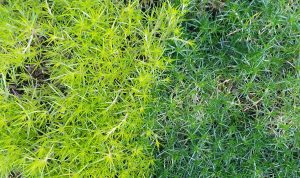
Irish and Scotch moss are prostrate herbaceous evergreen perennials in the carnation family (Caryophyllaceae) that superficially resemble moss. They are, however, flowering plants that thrive in full sun to partial shade rather than the moist, shady conditions where true mosses are found (mosses are primitive, non-flowering plants). The common name Irish moss generally refers to plants with emerald-green leaves while Scotch moss is generally used for cultivars with gold to chartreuse foliage. The species most commonly offered commercially is Sagina subulata, a native of western and central Europe that is hardy in zones 4-8. It is also sometimes referred to as heath pearlwort. Arenaria verna, also called moss sandwort, is also from Europe and hardy in zones 4-7. The two are virtually indistinguishable when not in bloom (the flowers of S. subulata are solitary while those of A. verna are borne in small clusters) and both have golden forms, and the names are often applied incorrectly in the horticultural trade.
Both species make dense, compact mats of ground-hugging foliage spreading to a foot or more wide and just 1-2 inches tall. Tufts of slender, subulate (awl-shaped) leaves cover thin, creeping stems.

Tiny star-shaped flowers are produced beginning in late spring and appear sporadically throughout the growing season. Rounded green buds on skinny stalks open to expose the five rounded white petals the same length as the pointed green sepals and ten white stamens. The flowers are sprinkled individually across the mat of leaves in S. subulata but occur in clusters on A. verna. These are followed by tiny smooth, brown, triangular seeds in oblong capsules. Under good conditions they will readily self-sow but is easy to remove where unwanted.

Use Irish and Scotch moss where a very low, fine-textured carpet of green or gold is desired, such as around stepping stones, between flagstones, or at the edges of a path as they tolerate light foot traffic. In areas where there is heavy foot traffic, creeping thyme (Thymus serpyllum) is a tougher alternative that will stand up to being walked on more frequently. These plants can be a good groundcover near the edges of water features or in rock gardens. Use Irish or Scotch moss for contrast in smaller containers or to simulate a lawn in miniature or fairy gardens. The bright chartreuse-yellow color of Scotch moss provides a brilliant contrast with plants with darker green foliage. Green or golden forms can be used as a ground cover around smaller spring flowering bulbs such as crocus, snowdrops (Galanthus), or small fritillarias (such as Fritillaria michailovskyi or F. meleagris). Trying to create a patchwork or checkerboard of the green and gold types is a real challenge as they readily grow together to dilute the effect.


Irish and Scotch moss grow best in full sun in the Midwest with regular water and excellent drainage. They will grow in partial shade, but will not be as compact here; in more southern areas they may need some afternoon shade. Fertilize sparingly to keep plants compact; high nitrogen levels can induce excessive foliar growth so the plants become mounded rather than forming a carpet. Water if necessary to keep evenly moist, but not wet. These plants have few pests, but slugs can damage the plants. The plants may be short-lived and clumps are susceptible to browning out with insufficient or excessive water.
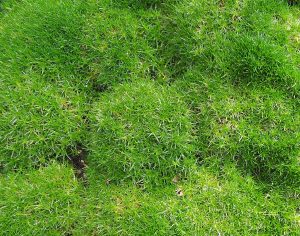
These plants can be propagated from seed or division. Cut narrow strips from established plantings or dig whole clumps and separate into pieces (being sure all have roots) for replanting. Plants grow at a moderate rate and make take several years to completely fill an area. Use many closely-spaced small transplants to cover large areas more quickly. Seeds can be started indoors several weeks before the average date of last frost, or direct sown in the garden in spring. Keep continuously moist as seeds will take 2-3 weeks to germinate.
– Susan Mahr, University of Wisconsin – Madison
Latest from Wisconsin Yard & Garden
Ask Your Gardening Question
If you’re unable to find the information you need, please submit your gardening question here:





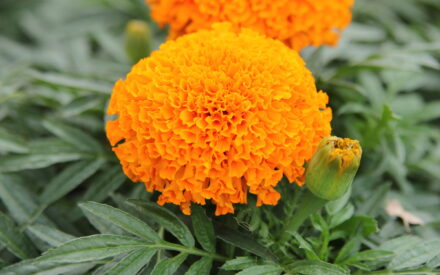 Marigolds
Marigolds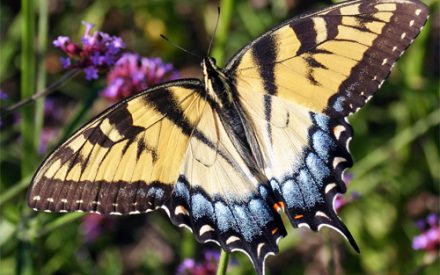 Create a Butterfly Garden
Create a Butterfly Garden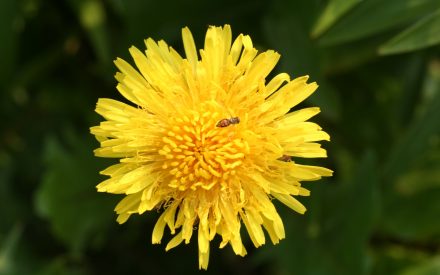 Plant Flowers to Encourage Beneficial Insects
Plant Flowers to Encourage Beneficial Insects Forcing Bulbs
Forcing Bulbs


